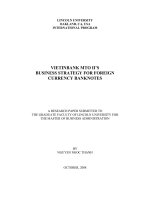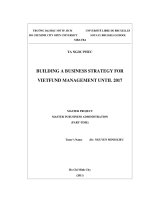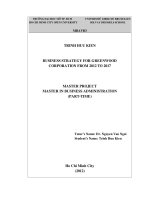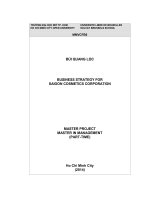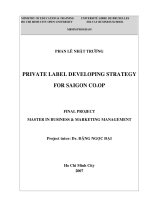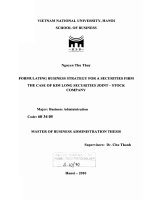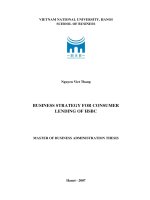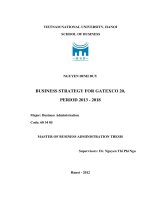Business strategy for SaiGon cosmetics corporation
Bạn đang xem bản rút gọn của tài liệu. Xem và tải ngay bản đầy đủ của tài liệu tại đây (499.25 KB, 66 trang )
TRƯỜNG ĐẠI HỌC MỞ TP. HCM UNIVERSITE LIBRE DE BRUXELLES
HO CHI MINH CITY OPEN UNIVERSITY SOLVAY BRUSSELS SCHOOL
MMVCFB6
BÙI QUANG LỘC
BUSINESS STRATEGY FOR
SAIGON COSMETICS CORPORATION
MASTER PROJECT
MASTER IN MANAGEMENT
(PART-TIME)
Ho Chi Minh City
(2014)
Declaration
I declare that all material presented in this research is my own work, or fully
and specifically acknowledged wherever adapted from other sources. I
understand that if at any time it is shown that I have significantly
misrepresented material presented in this research, any degree or credits
awarded to me on the basis of that material may be revoked.
Student’s Signature: Date:
Acknowledgement
I would like to express my special appreciation and thanks to my instructor
Professor Dr. NGUYEN MINH HA, you have been providing lots of guidance
and help for me. I would like to thank you for encouraging my research. Your
questions and comments greatly help me to complete this research
A special thanks to my family. Words cannot express how grateful I am to my
father and my mother for all the encouragement and of the sacrifices that you’ve
made on my behalf. Last but not least, I would like express appreciation to my
beloved wife PHUONG who spent sleepless nights with and was always my
support in the moments when there was no one to answer my queries.
Instructor’s Comments
TABLE OF CONTENTS
CHAPTER 1 – PROJECT OVERVIEW 1
1.1 Reason for choosing this topic 1
1.2 Problem statement 2
1.3 Project objectives 2
1.4 Research methodology 2
1.5 Data collection 3
1.6 The significance of this project 3
1.7 The structure of this project 3
CHAPTER 2 – LITERATURE REVIEW 5
2.1 Definition of strategy 5
2.2 The importance of strategy: 6
2.3 The components of strategy: 6
2.4 Strategy hierarchy 7
2.4.1 Corporate Strategy 7
2.4.2 Business Strategy 8
2.4.3 Functional level strategy 11
2.5 Strategy planning process 12
2.6 Tools and framework for environment analysis 14
2.6.1 PEST analysis 14
2.6.2 Porter’s five force model 15
2.6.3 SWOT analysis 16
2.6.4 TOWS 17
CHAPTER 3 – SITUATIONAL ANALYSIS 20
3.1 Vietnam situation 20
3.1.1 Political situation 20
3.1.2 Economy 20
3.1.3 Social factors 23
3.1.4 Technology 25
3.2 Vietnam Cosmetic and Personal care market overview 25
3.2.1 Fragrances (Perfume) 26
3.2.2 Hair care 27
3.3 Industry environment analysis 28
3.3.1 Barrier to entry 28
3.3.2 Power of buyer 29
3.3.3 Threat of substitute 30
3.3.4 Rivalry 31
3.4 Internal analysis 33
3.4.1 Business activities 33
3.4.2 Management analysis 35
3.4.3 Business performance 35
3.4.4 Marketing performance 38
3.4.5 SCC core capacity and competency 41
3.5 Summary of situational analysis 41
CHAPTER 4 – STRATEGY RECOMMENDATION FOR SCC 44
4.1 SCC Vision and Mission 44
4.1.1 Vision: 44
4.1.2 Mission 44
4.1.3 Objectives 44
4.2 Business strategy options for SCC 45
4.3 Strategy choice 46
CHAPTER 5 - DETAILED ACTION PLANS 48
5.1 Financial forecast for 2014-2015 period 48
5.2 Budget for key investment for 2014 49
5.3 Key investments and activities 49
CHAPTER 6 - CONCLUSION 54
6.1 Conclusion 54
6.2 Recommendation 54
LIST OF ABBREVIATIONS
GSO: Vietnam General Statistics Office
FMCG: Fast moving consumer goods
GT: General Trade
MT: Modern Trade
PEST: Political, Economic, Social and Technological
SCC: Saigon Cosmetics Corporation
SME: Small and Medium Enterprises
SWOT: Strength, Weakness, Opportunity and Threat
TOWS: Thread, Opportunity, Weakness and Strength
LIST OF TABLES
Table 2-1 Summary of tools used in environmental analysis 14
Table 2-2 TOWS matrix - strategic alternatives 19
Table 3-1 Vietnam income distribution by Urban and Rural 24
Table 3-2 Vietnam cosmetics and personal care market size 26
Table 3-3 Vietnam fragrance sub-category market value 27
Table 3-4 Vietnam import tax for cosmetics and personal care products 29
Table 3-5 Revenue contribution of SCC top brands 34
Table 3-6 SCC market research outcomes in 2012 39
Table 3-7 SWOT table for SCC 41
Table 4-1 Mapping TOWS alternatives to Porter's generic strategy 46
Table 5-1 Business plan for 2014 and 2015 48
LIST OF FIGURES
Figure 2-1 Porter's generic strategy 9
Figure 2-2 Strategy planning process 12
Figure 3-1 Vietnam GDP Growth overtime 21
Figure 3-2 Vietnam inflation rate over time 22
Figure 3-3 Vietnam population over time 23
Figure 3-4 Vietnam population demographics 24
Figure 3-5 Vietnam GDP per capita 30
Figure 3-6 Global cosmetics industry market growth, YOY (2003–2012) 31
Figure 3-7: SCC Corporate structure 34
Figure 3-8 SCC revenue and growth rate over time 36
Figure 3-9 SCC efficiency indicators 37
1
CHAPTER 1 – PROJECT OVERVIEW
1.1 Reason for choosing this topic
Vietnam economy sees the highest growth rate since early 2000s with Bilateral Trade
Agreement between the USA and Vietnam in 2000 and WTO membership in 2006.
Vietnam’s average GDP growth from 2000 to 2006 exceeded 5 percent per year and
peaked at 8.5 percent in 2007, translating to a total GDP of USD 60.9 billion in dollar
term. GDP growth has been slowed down since 2007 due to global economic crisis
and intrinsic problems of the economy, high reliance of the economy on the
construction booming and credit growth. Vietnam ended 2013 with a GDP growth of
5.42%. (GSO data)
Coming together with enormous economic growth, domestic business sector has been
facing increasing completion from large global players backed up with enormous
resources on their own home ground. As per data from Vietnam Foreign Investment
Agency (FIA), total new foreign direct investment (FDI) commitment to Vietnam
reached $21.6 billion in 2013, up 54.5 per cent year-on-year. The FDI disbursement
in 2013 witnessed a strong recovery with an increase of 9.9 per cent, reaching $11.5
billion, versus a decline of 4.9 per cent in 2012. More than 90% of Vietnamese
businesses are small and medium enterprises (SME), accounting for 40% of GDP.
Vietnamese SMEs are struggling to compete with global and regional players due to
lack of management expertise, small scale and simple technology.
(
/>Saigon Cosmetics Corporation (SCC), as a local SME, was also impacted by the
increasing competition. SCC experience a period of three from 2009 to 2011 with flat
revenue line and rapid declining marketing share. This project aims to put a real case
study through the framework of strategy formation process. By doing so, the project
would like to prove that there is a viable business strategy for SCC in particular and
for local Vietnamese SMEs in general even in a highly competitive environment.
2
Last but not least, being a shareholder of SCC and recently appointed to the position
of Director of Planning, I personally would like to formulate a clear business strategy
for SCC’s sustainable success and development in the long run.
1.2 Problem statement
SCC was one of Vietnam leading cosmetics and personal care companies with 10%
of market share back in 2000. For the period from 2000 to 2006, Vietnam’s joining
WTO open up the opportunities for global FMCG players such as Procter and Gamble
and Unilever entering the market.
Facing heavy marketing spending from competitors and not having an appropriate
strategy in place, SCC experienced a reduction in market share, stagnant sales and
low return on equity.
As a wake-up call, SCC Board requests for a complete review of SCC’s situation and
recommendation of strategy to reinstate its industry leader position and to improve
profitability.
1.3 Project objectives
The specific objectives of this project are set out as follows:
• To analyze macro-economic and industry environment for SCC products with
focus on personal care and personal fragrance market
• To analyze SCC conditions and the market where it operates to gain an
understanding of the SCC strengths, weaknesses, market opportunities and
threats.
• To develop alternative strategies and recommend a suitable business strategy
for Saigon Cosmetics Corporation with detailed business plan and action plans
1.4 Research methodology
To address the problem statement, the project starts with review of literature in the
field of strategic management with main focus on environment analysis and strategy
formulation. Factual analysis of Vietnam macro environment, Vietnam cosmetics and
3
personal care industry and SCC’s situations followed tools and frameworks in
strategic planning. The project closely follows the concepts Porter’s force model
together with the translation of outcome data into Heinz’s TOWS matrix for strategy
formulation.
1.5 Data collection
Primary data is collected directly from in-depth interviews with key personnel in SCC
(Chairwoman, CEO, CFO, Sales Director and Department heads). SCC financial and
market research data are provided by Finance and Marketing department.
Secondary data on cosmetics and personal industry are mainly extracted from Euro
Monitor Vietnam 2012 reports. Macro level data are sourced from Vietnam General
Statistics Office. Market share estimates are derived by compiling industry data and
SCC actual figures.
1.6 The significance of this project
Through the process of strategy planning process, this paper aims prove the
importance and usefulness of strategy planning to business in general and local SMEs
in particular. The structure of this paper intentionally lay outs the generic framework
for local firms to apply. The structure of this paper can be used as the basis for
comments, ideas and recommendation for enhancement. Promoting the implementing
and embedding strategic planning discipline in local SMEs operation is also the aim
of this paper.
1.7 The structure of this project
This project includes six chapters.
Chapter 1 is Project overview. This section sets out the project background and
rationale
Chapter 2 is Literature review. Theories in relation to strategic planning and
management process are reviewed and serve as the overall framework for factual
analysis in Chapter 3.
4
Chapter 3 is Situational analysis. Theoretical frameworks are put into practice. Real
data from macro economy, industry and SCC actual performance are analyzed and
summarized into SWOT matrix
Chapter 4 is Strategy recommendation for SCC. SWOT outcomes are put through
TOWS situational analysis for final strategy recommendation.
Chapter 5 is Detailed action plan. Strategy is translated into measurable financial
plans and detailed action items.
Chapter 6 is Conclusion. This last chapter summarizes areas of management
attention to ensure best outcome from strategy process.
5
CHAPTER 2 – LITERATURE REVIEW
This chapter of the research aims to summarize the current academic knowledge on
the subject of strategy. It also looks at developed tools and frameworks in strategic
management. Theories and frameworks will be utilized for actual analysis of SCC
situation in subsequent chapter.
2.1 Definition of strategy
Strategy is becoming a popular topic on the table of discussion of any board or high
level of management meeting. Rooted back in ancient Greek, strategy is defined as
generalship - high level plan to help troop leaders achieve goals under uncertainty.
Following this ancient definition of strategy, Steiner (1979), a key figure in the origin
and development of strategic planning, indirectly defines strategy as a way one did to
counter competitor actual or predicted moves. The definition of Steiner focuses on
the importance of directional decisions to organizations.
In modern business management, several academics write about and define strategy.
Johnson and Scholes (2006) define strategy as the direction and scope of an
organization over the long-term: which achieves advantage for the organization
through its configuration of resources within a challenging environment, to meet the
needs of markets and to fulfill stakeholder expectations.
Mintzberg (1994) defines strategy as a pattern in stream of decisions. Mintzberg takes
into account the nature of today business environment where technological advances
can change market conditions very quickly; hence, strategy is emergent in nature as
it is the product of initial intentions collides and accommodates with changing reality.
Tregoe and Zimmerman (1980) take the discussion further with the discussion on
core business drivers such as products, markets, customers, locations etc. Despite the
existence of multiple perspectives a business operation, only one can be the basis for
strategy.
It appears definitions differ on the outsets, all definitions does confirms the key
components of a strategy - the predetermined targets, the pattern in decision making,
6
the process of planning resources and last but not least the business perspectives. The
term strategy refers to a complex combination ideas, experiences, perceptions, and
expectations that provide direction for actions in pursuit of particular ends.
2.2 The importance of strategy:
Strategy is crucial to the company performance as it sets out the direction for the
company to move forward and priority in term of resources allocation. Ross and Kami
(2011) said that without a strategy, an organization is like a ship without a rudder,
going around in circles. Clear objectives help a company to develop short-term and
long-term growth plans that are very critical for sustained viability and success of a
company. Financial and human resources will be better utilized and deployed to areas
that need the most and help the company to established competitive advantage in the
long run. Urwick (1956) comments in his article that there is nothing which rots
morale more quickly and more completely than the feeling that those in authority do
not know their own minds.
2.3 The components of strategy:
Strategy comprises defining scope, goals and objectives, and resources deployment
via developing strategies and setting policy guidelines. Next they will be introduced
in details (Quinn & Ghoshal 1999).
- Scope: The scope of an organization refers to industries, products and market
segments. The breadth of scope actually determines the level of analysis and
data that need to be taken into consideration of strategy planning process.
Organization strategic scope reflects management view on firm’s purpose and
mission. This is the perspective aspect of strategy.
- Goals and objectives: high level vision and mission must translated into
specific objectives such as revenue growth, return on investments, market
share etc. Measurable objectives are critical for the evaluation of any strategy
implementation. Strategy effectiveness can be evaluated on measurable
indicators rather than general statement of mission.
7
- Resource deployments: Resources, financial or human, are limited. Strategy
formation provides direction and priority for resource deployment to archive
firm’s goal and objectives.
2.4 Strategy hierarchy
Strategy can be divided into three types. There is a hierarchy of strategy which is a
nesting of one strategy within another so that they complement and support one
another.
2.4.1 Corporate Strategy
Dess and Miller (1993) stated that corporate strategy as a company’s overall direction
in light of its general attitude toward growth and the management of its various
businesses and product lines. Corporate strategy fundamentally is concerned with the
selection of businesses in which the company should compete and with the
development and coordination of that portfolio of businesses. Corporate level strategy
is concerned with:
- Reach - defining the issues that are corporate responsibilities; these might
include identifying the overall goals of the corporation, the types of businesses
in which the corporation should be involved, and the way in which businesses
will be integrated and managed.
- Competitive Contact - defining where in the corporation competition is to be
localized.
- Managing Activities and Business Interrelationships: Corporate strategy seeks
to develop synergies by sharing and coordinating staff and other resources
across business units, investing financial resources across business units, and
using business units to complement other corporate business activities.
- Management Practices - Corporations decide how business units are to be
governed: through direct corporate intervention (centralization) or through
more or less autonomous government (decentralization) that relies on
persuasion and rewards.
8
Corporations are responsible for creating value through their businesses. They do so
by managing their portfolio of businesses, ensuring that the businesses are successful
over the long-term, developing business units, and sometimes ensuring that each
business is compatible with others in the portfolio
2.4.2 Business Strategy
Business strategy is the coordination of resources and more about developing and
sustaining a competitive advantage for the goods and services that are produced (Dess
and Miller 1993). Business strategy formulation phase deals with:
- Position the business against rivals
- Anticipating changes in demand and technologies and adjusting the strategy
to accommodate them
- Influencing the nature of competition through strategic actions such as vertical
integration and through political actions such as lobbying.
Michael Porter (1986) identified three generic strategies that can be implemented at
the business level to create competitive advantage and defend the adverse effect of
the five forces. The three generic strategies are Cost Leadership, Differentiation and
Focus He then subdivided the Focus strategy into two parts: "Cost Focus" and
"Differentiation Focus".
9
Figure 2-1 Porter's generic strategy
The Cost Leadership Strategy
Stonehouse and Snowdon (2007) summarize the requirement of this strategy -
firm to become the lowest cost producer of a product or service so that above-
average profits are earned even though the price charged is not above the industry
average. For this strategy to work, target customer base must be price-sensitive.
In order to archive lowest price and sustained profitability, firm must be able to
operate at the cost level lower than competitors. Lower cost base can be obtained
via economies of scales, high asset turnover, proprietary technology, preferential
access to raw materials
Customer loyalty might be a problem under cost leadership strategy. Price-
sensitive customers can easily switch their spending to a lower price product. In
certain situation, cost leader might give consumer the impression of low quality
product and make it harder for the firm to re-position itself to a differentiation
strategy or upgrade its brand position.
10
The Differentiation Strategy
Differentiation consists of offering unique products and services in various forms,
such as design, brand image, customer service and technology (Stonehouse and
Snowdon 2007). In other words, firms seek to be unique in its industry along some
dimensions that are widely valued by buyers. Differentiation strategy is more
suitable with customer segment that is not price-sensitive, market is competitive
or saturated, customers have very specific needs which are possibly under-served,
and the firm has unique resources and capabilities which enable it to satisfy these
needs in ways that are difficult to copy. Firm is rewarded for its uniqueness with
a premium price.
Differentiation strategy will require the following conditions to be a success:
- Good research, development and innovation.
- Ability to deliver high-quality products or services.
- Effective sales and marketing so that the differentiation factors are well
communicated and appreciated by customers.
Organizations following differentiation strategy need to be agile with new product
development processes. Competitors can attack using Focus Differentiation
strategies in different market segments.
The Focus Strategy or Strategic Scope
A focus strategy is aimed at a segment of a market within which a firm develops
uniquely low-cost or well-specified products for the market technology
(Stonehouse and Snowdon 2007). Under this dimension, the scope of competition
is finely described. The basis for competition is till either cost leadership or
differentiation. In adopting a narrow focus, the company focuses on a few target
niche markets where needs are specialized. The focus strategy has two variants.
In cost focus a firm seeks a cost advantage in its target segment, while
in differentiation focus a firm seeks to offer differentiated products and services
11
in its target segment. The target segments must either have buyers with unusual
needs or else the production and delivery system that best serves the target
segment must differ from that of other industry segments. Cost focus exploits
differences in cost behavior in some segments, while differentiation focus exploits
the special needs of buyers in certain segments.
Porter argued that only one strategy should be pursued at a time. The basis of his
argument is that costs for differentiation will defeat the basis of low cost strategy and
similarly standardized products that help achieving economies of scales will not
deliver differentiation values. Therefore, cost leadership and differentiation strategy
are naturally contradicts each other.
Porter’s rationalization (1986) is challenged by several researchers. According to
Fuller and Stopford (1992) the most successful companies are the ones that can
resolve what they call "the dilemma of opposites". Contemporary research shows
evidence that firms can be successful practicing hybrid strategy (Low cost and
differentiation strategy). Research writings of Davis (1984 cited by Prajogo 2007,
p. 74) state that firms employing the hybrid business strategy outperform the ones
adopting one generic strategy. In the context of market volatility and fast pace of
changing conditions, business agility and responsiveness is key for survival.
Depending on the market and competitive conditions hybrid strategy should be
adjusted regarding the extent which each generic strategy (cost leadership or
differentiation) should be given priority in practice.
2.4.3 Functional level strategy
The functional level of the organization is the level of the operating divisions and
departments. The strategic issues at the functional level are related to business
processes and the value chain (Dess & Miller 1993). Functional level strategies in
marketing, finance, operations, human resources, and R&D involve the development
and coordination of resources through which business unit level strategies can be
executed efficiently and effectively.
12
2.5 Strategy planning process
In today global market place, changes are occurring at unprecedented pace. Time and
distance is of less and less relevant thanks to the explosive growth of internet and
telecommunication. Strategy planning is not simply something that is practiced by
those largest firms but a requirement for every firm’s survival and success. The
strategy planning process can be demonstrated in the following figure.
Figure 2-2 Strategy planning process
Source: />Mission and vision setting is the very first step of strategic planning process. Bart and
Hupfer (2004) describe the mission statement as a noble cause to which the enterprise
contributes. To the extent that this purpose is achieved, the external world will not
only be a better place, but perhaps one that is truly great. Mission statement embodies
the organization’s purpose, the mission statement seldom changes without a
corresponding change in the fundamental purpose of the organization (Schwartz &
Cohn, 2002). The mission statement serves as the foundation for the vision statement
13
(Spallina, 2004). The vision statement is a forward-looking statement that defines the
ideal state of an organization in the foreseeable future (Bart & Hupfer, 2004;
Schwartz & Cohn, 2002). The gap between firm’s current state and the ideal state is
usually significant, driving firm-wide enthusiasm to close the gap. Working towards
a firm vision necessitates detailed and measurable objectives over time.
Environment analysis is the second step of the process is a review of the situation
where the firm operations –. Situation can be broadly classified into three levels
macro, industry and firm level. Macro and industry level analysis identify the firm’s
opportunities and threats while firm level review identify the firm’s strengths and
weaknesses.
Strategy formulation is the third steps. It produces a clear set of recommendations,
with supporting justification, aiming to create "sustainable" competitive advantages
to make the organization more successful. A good recommendation should be
effective in solving the stated problem(s), practical (can be implemented in this
situation, with the resources available), feasible within a reasonable time frame, cost-
effective, not overly disruptive, and acceptable to key "stakeholders" in the
organization.
Strategy implementation is the fourth steps that put plans and strategies into action to
reach goals. A strategic plan is a written document that lays out the plans of the
business to reach goals, but will sit forgotten without strategic implementation. The
implementation makes the company’s plans happen. Research indicates that strategy
implementation, rather than strategy formulation alone, is a key requirement for
superior business performance (Holman 1999; Flood, Dromgoole, Carroll & Gordon
2000; Kaplan & Norton 2000: 1). Leadership and change management are two most
crucial aspects of strategy implementation.
Last but not least is the evaluation and control. This does not finish the process but
rather completes the full process cycles. Managing the strategic plan is a continuous,
as well as dynamic, process because a single change in one aspect of the plan or
14
operational environment may require adjustments to the strategy as a whole. For this
reason, it’s important to frequently revisit the process so that the organization can
make adjustments and adapt as necessary.
2.6 Tools and framework for environment analysis
To support environment review, the following frameworks are normally utilized.
Table 2-1 Summary of tools used in environmental analysis
Analysis scope
Description
Tools
Outcome
Macro level
Social and economic
perspective
PEST analysis
Opportunities and
threats
Micro level
Industry and firm level
perspective
Porter’s Five
Forces
Strength and
weaknesses
Consolidation
Putting macro and
micro analysis outcome
in a four quadrant
matrix
SWOT
Firm’s overall
situation
Strategy
formulation
Situational analysis,
opportunities and
threats are matched with
firm’s weakness and
strength
TOWS
Strategic alternatives
2.6.1 PEST analysis
PEST stands for Political, Economic, Social and Technological analysis. PEST is a
framework of macro-environmental factors used in the environmental
scanning component of strategic planning process. Aguilar (1976) can be credited
with the origin of this strategic analytical technique. At that time, Aguilar talked about
ETPS – Economic, Technological, Political, and Social environment.
15
Political factors are basically to what degree the government intervenes in the
economy. Specifically, political factors include areas such as tax policy, labor
law, environmental law, trade restrictions, tariffs, and political stability. Political
factors may also include goods and services which the government wants to
provide or be provided (merit goods) and those that the government does not want
to be provided (demerit goods or merit bads). Furthermore, governments have
great influence on the health, education, and infrastructure of a nation.
Economic factors include economic growth, interest rates, exchange rates and
the inflation rate. These factors have major impacts on how businesses operate
and make decisions. For example, interest rates affect a firm's cost of capital and
therefore to what extent a business grows and expands. Exchange rates affect the
costs of exporting goods and the supply and price of imported goods in an
economy.
Social factors include the cultural aspects and include health consciousness,
population growth rate, age distribution, career attitudes and emphasis on safety.
Trends in social factors affect the demand for a company's products and how that
company operates. For example, an aging population may imply a smaller and
less-willing workforce (thus increasing the cost of labor). Furthermore,
companies may change various management strategies to adapt to these social
trends (such as recruiting older workers).
Technological factors include technological aspects such
as R&D activity, automation, technology incentives and the rate of technological
change. They can determine barriers to entry, minimum efficient production level
and influence outsourcing decisions. Furthermore, technological shifts can affect
costs, quality, and lead to innovation.
2.6.2 Porter’s five force model
This model is a framework for industry analysis and business strategy development.
It is based on industrial organization (IO) economics to derive five forces that
16
determine the competitive intensity and therefore attractiveness of a market.
Attractiveness in this context refers to the overall industry profitability. An
"unattractive" industry is one in which the combination of these five forces acts to
drive down overall profitability. A very unattractive industry would be one
approaching "pure competition", in which available profits for all firms are driven to
normal profit (Porter, 2008).
Three of Porter's five forces refer to competition from external sources, horizontal
competition forces and the remainders two are internal threats, vertical competition
forces (Porter, 2008). The five forces include:
- Substitute products or services,
- Established rivals,
- New entrants
- Bargaining power of suppliers
- Bargaining power of customers.
This five forces analysis is just one part of the complete Porter strategic models. The
other elements are the value chain and the generic strategies. Given limitation of
access to data, the scope of this paper is limited to five force analysis.
2.6.3 SWOT analysis
This is a structured planning method used to evaluate Strengths, Weaknesses,
Opportunities, and Threats involved in a project or in a business venture. There is no
clear documentation of SWOT origin. SWOT could be originated from the work of
Stanford University’s Albert Humphrey research project in 1950’s-1960’s. On the
contrary, SWOT can also be credited to two Harvard Business School Policy Unit
professors – George Albert Smith Jr and C Roland Christiensen during the early
1950s. Later in the 1950s another HBS Policy Unit professor Kenneth Andrews
developed its usage and application.
